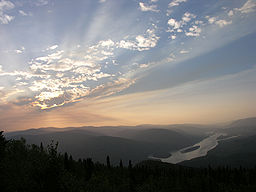Yukon River
| Yukon River | |
|
A view of the Yukon River near Dawson City, Yukon
|
|
| Countries | Canada, United States |
|---|---|
| State | Alaska, Yukon, British Columbia |
| Source | Llewellyn Glacier at Atlin Lake |
| - location | Atlin District, British Columbia, Canada |
| - coordinates | 59°10′N 133°50′W / 59.167°N 133.833°W |
| Mouth | Bering Sea |
| - location | Kusilvak, Alaska, United States |
| - elevation | 0 m (0 ft) |
| - coordinates | 62°35′55″N 164°48′00″W / 62.59861°N 164.80000°WCoordinates: 62°35′55″N 164°48′00″W / 62.59861°N 164.80000°W |
| Length | 3,190 km (1,982 mi) |
| Basin | 854,700 km2 (330,002 sq mi) |
| Discharge | |
| - average | 6,430 m3/s (227,073 cu ft/s) |
The Yukon River is a major watercourse of northwestern North America. The source of the river is located in British Columbia, Canada. The next portion lies in, and gives its name to, Yukon. The lower half of the river lies in the U.S. state of Alaska. The river is 3,190 kilometres (1,980 mi) long and empties into the Bering Sea at the Yukon-Kuskokwim Delta. The average flow is 6,430 m³/s (227,000 ft³/s). The total drainage area is 832,700 km² (321,500 mi²), of which 323,800 km² (126,300 mi²) is in Canada. By comparison, the total area is more than 25% larger than Texas or Alberta.
The longest river in Alaska and Yukon, it was one of the principal means of transportation during the 1896–1903 Klondike Gold Rush. A portion of the river in Yukon—"The Thirty Mile" section, from Lake Laberge to the Teslin River—is a national heritage river and a unit of Klondike Gold Rush International Historical Park. Paddle-wheel riverboats continued to ply the river until the 1950s, when the Klondike Highway was completed. After the purchase of Alaska by the United States in 1867, the Alaska Commercial Company acquired the assets of the Russian-American Company and constructed several posts at various locations on the Yukon River.
The name Yukon, or ųųg han, is a blend of the words in the Gwich'in phrase chųų gąįį han, which means white water river and refers to the visual effect of glacial silt in the Yukon River. The blend omits the consonant “ch” and the vowels “ąįį.” In 1843, the Holikachuks had told the Russians that their name for the river was Yukkhana and that this name meant big river. Although it did serve as the name of a big river, Yukkhana does not literally correspond to a Holikachuk phrase that means big river. The Holikachuks had borrowed the upriver language name and conflated its meaning with the meaning of Kuigpak, which is the Yup’ik name for the same river. Two years later, the Gwich’ins told the Hudson’s Bay Company that their name for the river was Yukon and that the name meant white water river.White water river in fact corresponds to Gwich’in words that can be blended to form Yukon.
...
Wikipedia

